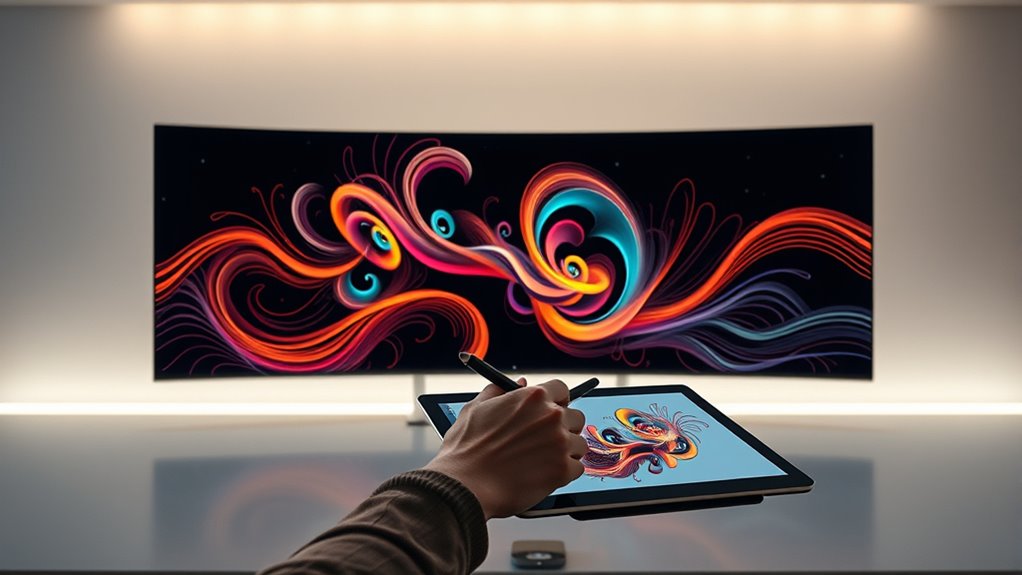Generative AI acts as your creative co-designer, accelerating your workflow and expanding your creative possibilities. It helps automate complex tasks, produce diverse design options, and push conventional boundaries. By analyzing vast data, it offers fresh ideas and personalized suggestions, enabling you to focus on refinement and strategic choices. This technology boosts innovation across industries, making design faster, smarter, and more dynamic. Keep exploring to discover how this partnership can transform your creative process.
Key Takeaways
- Generative AI acts as a collaborative partner, offering innovative design ideas and alternatives to enhance creativity.
- It streamlines workflows by automating repetitive tasks, allowing designers to focus on refinement and strategic decisions.
- AI-driven tools enable rapid exploration of design variations, accelerating project timelines and fostering experimentation.
- Algorithms adapt outputs based on user feedback, promoting personalized, high-fidelity visual designs.
- The integration of AI transforms traditional roles, positioning algorithms as essential co-designers in the creative process.

Generative AI design is revolutionizing how creators develop visuals, products, and experiences by automating complex processes and enabling innovation. With AI-driven tools, you can tap into a new domain of creativity, where algorithms serve as your collaborative partner. This fusion of technology and imagination accelerates the design process, allowing you to explore countless variations quickly. Instead of spending hours on initial sketches or prototypes, you input your ideas, and the AI generates multiple options that match your vision. This process exemplifies design automation, where repetitive tasks are handled seamlessly, freeing you to focus on refining concepts and storytelling.
Generative AI streamlines design, turning ideas into diverse, refined visuals and prototypes with speed and creativity.
AI creativity pushes the boundaries of what’s possible, offering fresh perspectives that might not emerge through traditional methods. Generative algorithms analyze vast data sets, learning patterns, styles, and structures, then applying this knowledge to produce unique designs tailored to your specifications. Whether you’re working on logos, user interfaces, or product prototypes, the AI can suggest innovative ideas that challenge your usual approach. It acts as a creative partner, providing inspiration and alternatives that enhance your workflow. As you iterate, the AI adapts, understanding your preferences and refining its outputs, making the process more intuitive and personalized.
Additionally, the use of color accuracy is crucial in ensuring that the generated designs meet high standards of visual fidelity, especially when the output is intended for real-world applications or branding. This automation doesn’t replace your role but amplifies your capabilities. You remain the decision-maker, guiding the AI with your input while it handles the heavy lifting. This synergy speeds up project timelines and opens opportunities for experimentation that might be impractical manually. For example, in fashion design, generative AI can help you visualize fabric patterns or explore color palettes, saving hours of manual sketches and mockups. In digital art, it can generate complex backgrounds or character designs that you can customize further, giving you a solid foundation to build upon.
Furthermore, the integration of AI creativity into your workflow fosters a more inclusive environment for experimentation. You no longer need to be a master of every technique; instead, you leverage the AI’s capabilities to extend your reach. The automation of routine tasks allows you to concentrate on strategic and aesthetic decisions, elevating the quality of your work. As this technology advances, it will continue to adapt to your style, making the design process more fluid and responsive. Embracing generative AI design empowers you to innovate rapidly, push creative boundaries, and develop visuals, products, and experiences that stand out in a crowded marketplace.
Frequently Asked Questions
How Does Generative AI Impact Traditional Design Workflows?
Generative AI impacts traditional design workflows by streamlining tasks through automation integration, allowing you to focus more on creativity. It enhances creative collaboration, offering new ideas and iterations faster than before. You can quickly generate concepts, refine designs, and explore options, making the process more efficient. This shift encourages you to work alongside AI as a co-designer, blending human intuition with machine-powered innovation for better and faster results.
What Are the Ethical Considerations in Ai-Driven Design?
You need to address ethical considerations in AI-driven design by focusing on bias mitigation to prevent unfair outcomes and ensure diverse representation. Protect privacy concerns by safeguarding user data and being transparent about data use. Always question how algorithms influence design choices, and aim for responsible AI deployment. By doing so, you foster trust and create more equitable, respectful designs that benefit all users.
Can Generative AI Replace Human Creativity Entirely?
You might think AI can completely replace human creativity, but that’s like expecting a robot to feel a soulful masterpiece. Generative AI can’t replicate your unique creative autonomy or the depth of artistic originality you bring to the table. It’s a tool that enhances your ideas, not replaces them. Your imagination, emotional insight, and personal touch remain irreplaceable, making you the true artist behind every innovative design.
How Does AI Ensure Diversity and Inclusivity in Design Outputs?
AI promotes diversity and inclusivity in design outputs through bias mitigation techniques that identify and reduce harmful stereotypes. By incorporating diverse data sets, AI guarantees cultural representation across different groups, reflecting a wider range of perspectives. You can actively guide the AI by setting inclusive parameters and reviewing outputs, making sure your designs embrace multiple identities and avoid unintentional biases, ultimately creating more equitable and representative solutions.
What Skills Are Needed for Designers to Collaborate Effectively With AI?
Did you know 78% of designers say collaboration with AI boosts creativity? To work effectively with AI, you need strong collaborative communication skills so you can clearly articulate your ideas and interpret the AI’s suggestions. Technical literacy is essential too; understanding how algorithms work helps you guide AI outputs and troubleshoot issues. Combining these skills allows you to leverage AI as a true partner in the design process.
Conclusion
As you embrace generative AI as your co-designer, you open endless creative possibilities. Imagine using AI to craft innovative product prototypes in hours instead of weeks. For instance, a furniture designer could input basic parameters, and the AI generates multiple unique concepts, saving time and inspiring new ideas. By collaborating with algorithms, you become more inventive and efficient, transforming your design process into a dynamic partnership that pushes boundaries and sparks innovation.









